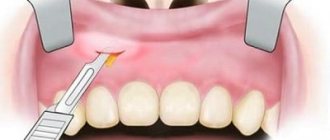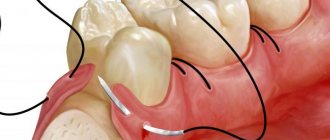Causes of flux after extraction
In dentistry, gumboil refers to an inflammatory process that forms inside soft tissues and manifests itself in the form of swelling, purulent discharge, fever and other unpleasant syndromes. The medical term is periostitis. There is only one mechanism for the development of flux: pathogenic bacteria provoke the development of infection, which penetrates into the gums and periosteum through microtubules.
Dangerous symptoms!
- Deep inflammatory process.
- Invasive tooth extraction, after which the gums are injured. If additional anti-inflammatory therapy is not given, infection may develop.
- Poor-quality temporary prosthesis, which caused gum injury and infection.
- Dry socket syndrome.
Tooth extraction: swelling
Tooth extraction is a difficult operation that traumatizes the tissue surrounding the tooth. Therefore, it is not surprising that unpleasant consequences occur after tooth extraction: the most common of them is swelling. Patients often complain that after tooth extraction, the gums become swollen, swelling of the cheek or a slight gumboil appears. This is caused by partial destruction of the soft tissue around the tooth. This is unpleasant, but if the tumor is small, it goes away on its own in 2-3 days. To relieve swelling after tooth extraction, ice can be applied to the cheek for about 10 minutes. If the swelling has not gone away after a day, apply heat. Keep the heating pad for 20 minutes, then take a break for 10 minutes and put the heating pad back on.
Sometimes swelling can be caused by an allergy to the anesthesia. In this case, histamine, an antiallergic drug, will help. But if the swelling increases, then it may be a sign of inflammation that has arisen after tooth extraction. In this case, you should immediately consult a doctor.
How long does the flux last after tooth extraction?
Many patients wonder why the flux does not go away after tooth extraction. The answer to this question is obvious: if the infection has penetrated deep into the tissue and an inflammatory process has developed, tooth extraction is unlikely to stop it. If the pathology arose immediately after extraction, then you should not expect that the problem will disappear on its own. Of course, there are situations when the initial inflammation goes away due to the protective properties of the body. However, gumboil is a result, not a start, so it practically cannot disappear on its own, even if it breaks through on its own and some of the pus comes out. Moreover, neglected periostitis develops into an abscess and phlegmon, which are even more difficult to cure. The most serious consequences of flux are blood poisoning and death, which often happened in the past when medicine did not have effective treatment methods.
After dental treatment, the gums became inflamed
The cause of inflammation is a developing purulent process (abscess). A new growth may appear in the form of a white ball on the gum. These problems should not be cultivated. You should immediately seek qualified medical help. The development of cysts on tooth roots is not just “some natural process.” This is inflammation, leading to the dissolution of bone tissue, inflammatory processes have a serious impact on the entire immune system, lymph nodes, etc. Therefore, if after treatment of a tooth the lymph node becomes inflamed, then this is a symptom with which you need to go back to the dentist . You yourself can diagnose the process of inflammation of the tooth root, you will be able to evaluate all the accompanying symptoms, but not a single patient will be able to provide treatment corresponding to the severity of the disease on his own. Leaving the source of inflammation, suppressing acute symptoms somehow with everyday methods, is the wrong way of treatment, which keeps all the problems inside. If you feel discomfort or inflammation after treatment, you should visit a dentist. Treatment of inflammation at the very beginning is easier than treatment of a purulent abscess
The gums near the wisdom tooth are inflamed
Painful eruption of wisdom teeth is normal. Usually, the growth of wisdom teeth is always painful. The painful eruption of the “eights” is caused by the absence of their predecessor milk teeth. However, these teeth, rudimentally inherited by man from his previous rounds of evolution, can erupt with great difficulty. Sometimes surgery is necessary. If the gums around a wisdom tooth are inflamed, then there is no reason to be alarmed. The growth of wisdom teeth is long-term and can last for several years, periodically causing redness and inflammation of the gums. Discomfort can only be relieved by time: the tooth will erupt and everything will pass.
But the difficulties that occur during the eruption of wisdom teeth will require you to come to the dentist for a consultation. If the painful process upsets and worries you, then go for a consultation. Difficulties may occur during the eruption of wisdom teeth. A dentist with good experience will instantly either remove your doubts and reassure you, or provide dental assistance. Rinsing daily may be sufficient to prevent inflammation.
Signs that require a visit to the dentist during wisdom teeth eruption are as follows:
- Temperature increase;
- Pain when swallowing;
- Swelling of the submandibular lymph nodes;
If after the removal of a wisdom tooth the temperature remains between 37 or 38, you must consult a dentist again.
Abscess after wisdom tooth removal
Soft tissues, the site of tooth extraction, deeper tissues - all these places are susceptible to infection and the development of an inflammatory process. A developing abscess can be a source of not only pain, but also a full-fledged, severe purulent abscess. You should not hesitate, with this question, you should immediately consult a doctor!
To relieve inflammation after tooth extraction, proper treatment is necessary.
- Patients are prescribed antibiotics
- Strict adherence to daily hygiene
- In difficult cases, surgical procedures are performed within the walls of the dental clinic to open the abscess.
The eruption of wisdom teeth can be difficult, cause inflammation of the gums and require medical care within the walls of a dental clinic
Inflammation under the crown of the tooth
Crowns installed under metal-ceramic prostheses are associated with grinding down the tooth and depulping it. The destruction of teeth under the crown cannot be determined in a timely manner because such teeth are devoid of nerves. Often in such cases, when removing crowns, there are completely rotten teeth underneath, which need to be urgently removed.
Therefore, any pain under the crown is a symptom that helps us save our tooth. You can’t wait and hesitate - go to the dentist immediately!
Gum inflammation can be caused by other diseases
Inflammation of the gums during periodontal disease and gingivitis is the main symptom of the disease. Periodontal disease is an inflammation that specifically affects the periodontal tissues, leading to subsidence of the gums and a decrease in the volume of bone tissue. Periodontitis, Gingivitis - all these gum diseases require treatment and monitoring. Unlike painful inflammation of the gums of the tooth root, gingivitis in the presence of gum inflammation does not cause such obvious pain. The disease gingivitis occurs with possible bleeding, redness of the gums, and ulceration of the mucous membrane.
Any inflammation of the gums, accompanied by pain, swollen lymph nodes, bad breath, bleeding, requires treatment
Swelling, temperature and other symptoms
The main symptom by which flux can be visually identified is a soft tissue tumor and a characteristic purulent sac that forms during the development of the pathology. Over time, the clinical picture worsens. For example, huge tumors on the gums and cheeks are the result of severe periostitis. One of the characteristic symptoms of flux is severe pain that spreads over a large area of the jaw, and also radiates to the ears, neck and other parts of the head. The temperature after removal of a tooth with flux (if it is preserved) is usually consistently high (from 38 degrees), but in some situations the body temperature does not go beyond normal levels. The film covering the hole becomes brown or grayish in color, and bad breath appears. Read about complications after tooth extraction in the article.
Attention!
It is important to understand that tooth extraction is a surgical procedure. Inflammation, minor bleeding and pain are quite common. These symptoms should completely subside within a few days. If the pain lasts more than five days, and the above-mentioned manifestations of flux also occur, you should consult your doctor.
What to look for
The most serious consequences that can occur after wisdom tooth removal:
- Alveolitis. This is an acute inflammatory process. It begins in the tooth socket and gradually spreads to other gum tissues. The most common reason for the development of alveolitis is improper care after removal.
- Paresthesia. Develops when the root of the jaw nerve is damaged or irritated. Manifested by a feeling of tingling, burning, numbness.
To avoid developing serious problems, monitor your oral health. The first symptoms are not difficult to replace:
- Bleeding from the socket. This is not always a sign of complications. Immediately after removal this is a normal reaction of the body. In the first minutes after tooth extraction, bleeding will be slightly heavier. The dentist treats the wound with antiseptics and packs it. After some time, the bleeding stops. Slight bleeding persists for 2-3 hours. This is also normal. You should pay attention to bleeding if it is profuse and begins several hours after removal. In this case, contact a specialist immediately.
- Swelling and pain. This is also a natural reaction. Pain occurs as the anesthetic wears off. Normally it lasts 2-3 days. At the same time, the gums swell slightly. You should sound the alarm if the swelling transfers to the cheek. In complex cases, the tumor can be very large. Severe swelling is one of the symptoms of alveolitis.
- Fever. On the first day after removal, the temperature rises to 37 degrees. Such an increase is within normal limits, especially if the operation was complicated. When the temperature lasts more than a day or rises strongly, this is a symptom of inflammation. To prevent the inflammatory process from spreading to neighboring tissues, visit a dental clinic.
- Suppuration. The inflammatory process, accompanied by suppuration, has pronounced symptoms. Suppuration is indicated by a putrid odor from the mouth and an unpleasant taste. When examining the tooth socket, you may notice gray plaque or white purulent contents. In this case, you need to go to the dentist immediately.
- Headache. Immediately after wisdom tooth removal, headache is normal. It is caused by stress and anesthetic drugs. If the headache is severe and is accompanied by fever, swollen lymph nodes, and weakness, we recommend visiting a doctor.
Dentistry for those who love to smile
+7
Make an appointment
Treatment of flux after tooth extraction
Flux occurs after tooth extraction: what to do? Firstly, you should not delay your visit to the dentist. The sooner you start treatment, the higher the chances of a speedy recovery. The doctor will quickly make a diagnosis and draw up an optimal rehabilitation plan. The method of treating flux after tooth extraction depends on the severity of the pathology.
Conservative
Treatment is carried out with antibiotics that suppress the activity of bacteria. Antibiotics after tooth extraction with flux: Lincomycin; Ciprofloxacin, Amoxiclav and their broad-spectrum analogues
Along with antibiotics, anti-inflammatory and painkillers are prescribed (Nimesil Diclofenac, Ketanov, etc.). Metrogyl Denta and Levomekol ointments help to cope with inflammation. After tooth extraction with flux, to clean and protect the oral cavity, regular rinsing with a solution of Chlorhexidine, Miramistin or soda is required (if there is no access to the first two drugs).
Attention!
Consultation with the body is required before use.
Surgical
If the flux is at an advanced stage and a purulent sac has formed, the most effective measure is surgery. This procedure is called periostotomy. The dental surgeon makes an incision in the area of inflammation, after which he installs a special drainage to drain the pus. When the swelling subsides and all the pus comes out, the patient is given stitches. Surgical treatment does not exclude the use of antibiotics and other anti-inflammatory and antiseptic agents described above.
Alveolitis after tooth extraction: why it occurs, how to identify and treat
Normally, a person forgets about an extracted tooth within a few days. During this time, the pain finally subsides, and the damaged area is overgrown with new epithelium. However, there are cases when tooth extraction is accompanied by serious side effects. One of them - alveolitis - is an inflammatory process that affects the tooth socket and the gum around it. Acute alveolitis requires immediate intervention. Inflammation that begins from the walls of the socket can spread to soft tissue and penetrate deep into the bone. There are cases when it caused such dangerous and painful consequences as periostitis (suppuration and necrosis of the periosteum), osteomyelitis (destruction of the jaw bone), lymphadenitis (damage to the lymph nodes) and even sepsis.
Why does it occur
Alveolitis of the extracted tooth socket is a direct consequence of its infection. There may be several reasons for wound infection: • the complex nature of the removal, requiring an incision in the gum and extraction of the tooth from it by sawing (with complete destruction of the tooth; with curved roots; with increased fragility of the dental tissue; with an unerupted or barely visible wisdom tooth);
• violation by the patient of the requirements of the rehabilitation period (failure to comply with oral hygiene; intensive or frequent rinsing of teeth, which contributes to the premature separation of a blood clot - a natural antibacterial barrier; irritation of the wound with hot, rough or spicy food; smoking).
• poorly performed medical procedure (poor cleaning of the socket with penetration of tartar into it; fragments of crushed bone or fragments of tooth roots left in it; unresolved purulent processes);
Factors that provoke the development of alveolitis may be the following:
• reduced immunity; • hypothermia of the body; • contacts with carriers of infectious diseases; • the presence of acute pathologies of a bacterial or viral nature in the oral cavity or nasopharynx (for example, teeth affected by caries, inflamed gums, tonsils); • gastrointestinal tract infections; • chronic diseases in the acute stage.
How it manifests itself
Pain symptom is the main precursor to the development of alveolitis. If, with a successful outcome of tooth extraction, the unpleasant sensations gradually disappear after a few days, then with alveolitis, everything happens exactly the opposite. The pain does not leave the patient, but intensifies, reaching its peak on days 2-5 after surgery. Having arisen in an injured socket, it can cover the entire maxillofacial area, spreading to the ear, temporal region or neck.
In addition to pain, the patient may be bothered by the following manifestations of the disease:
• general malaise, loss of strength, temperature rise to 38°C; • inflammation of the submandibular lymph nodes; • smell of rotting breath; • yellowish-gray plaque inside the socket freed from the thrombus; • blood-red color of the gums, its soreness and swelling; • a bitter taste that often appears in the mouth; • cheek swollen from swelling; • activation of secondary foci of oral infection.
Depending on the intensity of the pathological process, its nature is determined by specialists as pronounced, moderate or mild. However, not a single form of this disease can be ignored by the patient.
How to treat
Taking anesthetics and washing the inflamed hole with disinfectant solutions at home is ineffective. They can only reduce, but not stop, the patient’s suffering. The main danger of self-medication is that it can smooth out the symptoms of inflammation. Therefore, in this situation, you cannot do without visiting a dentist. Only a set of procedures will stop the pathological process. The development of a treatment plan is preceded by a thorough diagnosis: visual examination and x-ray or radiovisiography of the dental fossa.
The scheme of medical care for identified alveolitis is as follows:
1. Anesthesia of the inflamed area - anesthesia at the site of inflammation. 2. Curettage of the socket - removal of foreign bodies from it using a special surgical device: tooth fragments or fragments of inert tissue, opening and cleaning out granulations. 3. Repeated rinsing of the hole with an antiseptic and anesthetic drug, followed by placing a special medicine into it, which simultaneously heals, protects the wound and relieves pain. At home, as prescribed by the doctor, the patient takes analgesics, vitamins, and adheres to a gentle diet.
For alveolitis of severe severity, antibiotics with a local or general effect are prescribed. Sometimes dressings with balms and gels are used to soothe the gums. If signs of tissue destruction are detected, proteases are indicated - drugs that improve the microflora in areas of cell death.
The recovery process will be effective if you follow the doctor’s orders every day for 5-7 days.
A set of emergency treatment measures and following all the dentist’s recommendations allows you to quickly achieve the expected effect. After 5-7 days, improvement occurs: the pain goes away, the hole begins to heal. After a few days, the swelling of the gums completely disappears. But even after this, it is necessary to adhere to hygiene standards and other medical prescriptions. It wouldn’t hurt to make a few follow-up visits to a specialist.
Prevention methods
A simple set of primitive measures will help you avoid alveolitis and its serious complications. So, after tooth extraction you should:
• hold the hemostatic tampon in the hole, biting it, for at least 15 minutes; • be careful when caring for the oral cavity and during meals so as not to deprive the socket of a blood clot formed in it; • avoid external factors that contribute to excessive cooling or warming, do not eat or drink anything too hot or too cold; • do not come into contact with infectious patients; • if you have cancer, HIV, or diabetes, notify your dentist about your diagnosis in order to take the necessary course of antibiotics in such cases (it will also not hurt older patients).
By following these recommendations, you will safely avoid infection of the injured area. This will help you preserve the entire row of remaining teeth for a long time.
Recommendations for treatment and prevention
How long does the flux last after tooth extraction if treatment is started in a timely manner? In the early stage, symptoms disappear within two to three days. In severe forms (large purulent gum after tooth extraction), when surgical intervention is required, rehabilitation takes longer and takes up to several weeks. What is important is how the patient follows the doctor’s recommendations and what measures he takes to speed up recovery.
Prohibited!
- self-medicate and self-prescribe antibiotics;
- apply warm compresses and use warming ointments, as this promotes the growth of bacteria;
- take aspirin before surgery, as it thins the blood;
- During the recovery process, active physical activity, going to the sauna and swimming pool are prohibited (even when the jaw no longer hurts).
Flux after wisdom tooth removal occurs much more often, since the procedure for removing “eights” is usually very traumatic, which affects the condition of the soft tissues. After the removal of wisdom teeth, you need to especially carefully monitor your condition and take all necessary preventive measures to minimize the risk of developing periostitis.
Symptoms of physiological and pathological eruption of wisdom teeth
Tooth eruption can occur physiologically or pathologically. Discomfort occurs in any case, but if the “eight” grows without complications and other teeth do not interfere with it, inflammation usually does not occur. The complex of symptoms may vary, but most note the appearance of such phenomena as:
- engorgement and hardening of the gums;
- distension in the area of eruption;
- aching pain of varying intensity.
Important! Symptoms can vary significantly from person to person. Even one patient can experience completely different sensations when wisdom teeth erupt on the lower and upper jaws.
Severe pain, tumors, and inflammatory processes accompany pathological eruption. In this case, saving the tooth is not always advisable. If your wisdom tooth is cutting out and your gums hurt, you need to see a dentist.
Signs of pathological eruption are:
- constant, intense, aching pain;
- swelling of the gums or cheeks;
- inflammation of the lymph nodes;
- pain when swallowing;
- temperature increase.
Are you experiencing one or more symptoms? Don't delay your visit to the doctor. Such phenomena may be a sign of pericoronitis, purulent inflammation, abscess and other pathologies. Without adequate treatment, the inflammatory process will spread to adjacent tissues, and phlegmon will form in the oral cavity. In advanced cases, the problem can only be dealt with surgically in a hospital setting. Purulent inflammation is opened through external incisions, the treatment process is accompanied by the use of antibiotics.
Even if the symptoms of wisdom tooth eruption do not cause concern, it is recommended to visit a dentist. This is necessary to exclude a pathological process.
The doctor will refer you for an x-ray or computer examination. It helps determine the position of the new tooth relative to the existing ones and assess whether there is enough space for it. The photographs clearly show any deviations in the figure eight position. Based on the examination, the doctor will decide whether the wisdom tooth needs to be removed.











